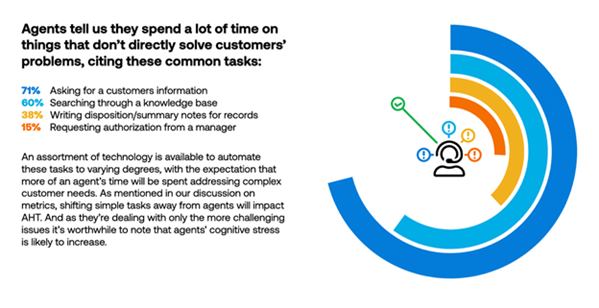
Over five million people globally work as call centre agents, including 1.3 million people in the UK. Many of them face challenges according to a new research report from artificial intelligence (AI) firm ASAPP, CX: The Human Factor.
Training, coaching, legacy technology, and lack of career opportunities top the list of issues for agents along with handling irate customers.
Training/Coaching
A recurrent response by agents is that they want to be empowered to help customers. It’s a mentally challenging job being on the front line of helping people. We count on agents for assistance with a broad array of consumer needs including technology, healthcare, housing, finance, utilities, entertainment, travel, and internet access. However, the world of agents has also been complicated by legacy technology that has driven more complexity in agents’ roles.
Training is a major cost for the industry and CX leaders often deal with 40% agent churn. 51% of poorly trained agents are pessimistic about their careers—an outlook that can lead to poor performance, unhappy customers, and agent burnout—yet 61% of agents who received good training felt optimistic.
While companies often look at ways to reduce the time it takes to train agents, the report suggests reduced training lowers the confidence and competence of agents, which can lead to higher absenteeism. There is room for change with the use of AI that learns from tenured agents’ work and uses that information to train new hires with practical and credible training. This ability to shorten the learning curve and get agents ready to be “on-the-floor,” is cause for optimism.
The call centre industry is metric driven with a culture of continuous improvement. Nevertheless, 78% of agents report metric manipulation. The challenge is that agents want to serve people, but they are not being served themselves by current metrics, which measure a fraction of their overall customer interactions and don’t provide a real picture of their work.
The most common reasons agents cite as cause for metric manipulation are:
- 33% Compensation Bonus
- 27% Managerial Pressures
- 21% Quotas
While 63% of agents report feedback is helpful and encouraging, 27% of agents say it doesn’t reflect their overall work—and 37% reported that it has been difficult to get feedback during the pandemic. When agents receive a bad CSAT review in real-time, the metric creates negativity and anxiety, especially when it’s unrepresentative of their work. This anxiety can have an outsized impact on absenteeism—itself a metric of the customer experience.
With AI, the industry has an opportunity to modernize technology and reduce anxiety, as it can extract data and analysis from every customer interaction to provide the analytics the agents and company needs. Additionally, AI now enables the ability for coaching and support, alerting and enabling supervisors in real-time to an agent’s need for help with difficult calls.
The Technology Gap
There is a strong relationship between the degree an agent finds the technology at their company to be satisfactory or sufficient, and how happy they are on the job. Therefore, investments in new technology are important for retaining a workforce. 45% of agents believe that technology advancement in call centres is behind the times. 37% cited current technology doesn’t help them complete tasks faster or doesn’t do what they want it to do and a further 43% experiencing their systems crashing or freezing.
51% of agents believe AI will help solve customer’s repetitive problems and 44% agree that AI will improve their efficiency.
Yet, automation should not be exclusively about eliminating human involvement. Native AI platforms can automate a customer’s journey up front and throughout a call. During the call itself, AI is supporting an agent through complex workflows for each interaction. This end-to-end, AI-empowered system is making people more effective, efficient, and shortening the time required by an agent to make their work-lives easier.
Unfortunately, most automation deployed today is poorly designed, limited in reach and yields a bad customer experience. People are this industry’s most valuable resource and ensuring they have the best technology, tools, and training to cope with the challenging demands of customer service is critical.
Customer Challenges
Irate customers have been a subject in the industry for a long time and the report indicates that:
- 81% of agent respondents have experienced verbal abuse
- 36% of agent respondents have been threatened with violence
- 21% of female agents and 9% of male agent respondents have been sexually harassed
There are signs of change and technology now exists for companies to tackle this problem at scale. With artificial intelligence it is now possible to transcribe calls in real-time, flag abusive calls and notify supervisors. It’s a tough topic to address for the industry but one that is central to agents’ well-being, particularly with employee attrition. Yet, the overwhelming majority (90%) of agents stated that calls with customers made their day.
Reduce Complexity of Calls
Pulitzer-prize writer James Michener said, “there are no insoluble problems. Only time-consuming ones.” 72% of agents want to solve simple customer problems, yet during the pandemic customer engagement reached a pinnacle of long wait times and complexity due to massive increases in inbound call volumes, reduced agent availability and technology systems not designed for the work from home environment.
Four tasks were listed by agents for taking the longest time:
- Asking for a customer’s information
- Searching for answers to customer questions in the company’s knowledge system.
- Writing summary notes of the call
- Requesting support from a manager
However, with the right use of AI, all these tasks can be automated to simplify and reduce the call time.

Today’s call centre challenges are not just about technology and managing costs. It’s also about brand, reputation and delivering a high-quality experience. On the positive side, if companies engage customers where they are and provide anytime, anywhere service convenience (even in social channels), the customer experience can be a powerful voice for the brand, a core part of a company’s strategy and value proposition, and most importantly, customer lifetime value.




